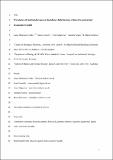Files in this item
Prevalence of multimodal species abundance distributions is linked to spatial and taxonomic breadth
Item metadata
| dc.contributor.author | Henriques Antão, Laura | |
| dc.contributor.author | Connolly, Sean R. | |
| dc.contributor.author | Magurran, Anne E. | |
| dc.contributor.author | Soares, Amadeu | |
| dc.contributor.author | Dornelas, Maria | |
| dc.date.accessioned | 2017-11-06T08:46:32Z | |
| dc.date.available | 2017-11-06T08:46:32Z | |
| dc.date.issued | 2017-02 | |
| dc.identifier | 247458142 | |
| dc.identifier | 007907be-b1c4-4be7-bb4c-770bd223a423 | |
| dc.identifier | 84996656659 | |
| dc.identifier | 000393693300007 | |
| dc.identifier.citation | Henriques Antão , L , Connolly , S R , Magurran , A E , Soares , A & Dornelas , M 2017 , ' Prevalence of multimodal species abundance distributions is linked to spatial and taxonomic breadth ' , Global Ecology and Biogeography , vol. 26 , no. 2 , pp. 203-215 . https://doi.org/10.1111/geb.12532 | en |
| dc.identifier.issn | 1466-8238 | |
| dc.identifier.other | Bibtex: urn:34ea5de858ccf4b18006d1cc7692e5da | |
| dc.identifier.other | ORCID: /0000-0002-0036-2795/work/43550258 | |
| dc.identifier.other | ORCID: /0000-0001-6612-9366/work/30024671 | |
| dc.identifier.uri | https://hdl.handle.net/10023/11994 | |
| dc.description | We thank the University of St Andrews MHD Cluster and the Bioinformatics Unit (Wellcome Trust ISSF grant 105621/Z/14/Z). L.H.A. was supported by Fundação para a Ciência e Tecnologia, Portugal (POPH/FSE SFRH/BD/90469/2012). A.E.M. acknowledges the ERC (BioTIME 250189). M.D. acknowledges funding from the Marine Alliance for Science and Technology Scotland (MASTS), funded by the Scottish Funding Council (grant reference HR09011) and contributing institutions. | en |
| dc.description.abstract | Aim. Species abundance distributions (SADs) are a synthetic measure of biodiversity and community structure. Although typically described by unimodal logseries or lognormal distributions, empirical SADs can also exhibit multiple modes. However, we do not know how prevalent multimodality is, nor do we have an understanding of the factors leading to this pattern. Here we quantify the prevalence of multimodality in SADs across a wide range of taxa, habitats and spatial extents. Location. Global. Methods. We used the second-order Akaike information criterion for small sample sizes (AICc) and likelihood ratio tests (LRTs) to test whether models with more than one mode accurately describe the empirical abundance frequency distributions of the underlying communities. We analysed 117 empirical datasets from intensely sampled communities, including taxa ranging from birds, plants, fish and invertebrates, from terrestrial, marine and freshwater habitats. Results. We find evidence for multimodality in 14.5% of the SADs when using AICc and LRT. This is a conservative estimate, as AICc alone estimates a prevalence of multimodality of 22%. We additionally show that the pattern is more common in data encompassing broader spatial scales and greater taxonomic breadth, suggesting that multimodality increases with ecological heterogeneity. Main conclusions. We suggest that higher levels of ecological heterogeneity, underpinned by larger spatial extent and higher taxonomic breadth, can yield multimodal SADs. Our analysis shows that multimodality occurs with a prevalence that warrants its systematic consideration when assessing SAD shape and emphasizes the need for macroecological theories to include multimodality in the range of SADs they predict. | |
| dc.format.extent | 13 | |
| dc.format.extent | 466064 | |
| dc.language.iso | eng | |
| dc.relation.ispartof | Global Ecology and Biogeography | en |
| dc.subject | Community structure | en |
| dc.subject | Diversity patterns | en |
| dc.subject | Lognormal | en |
| dc.subject | Logseries | en |
| dc.subject | Poisson lognormal mixture | en |
| dc.subject | Spatial scale | en |
| dc.subject | Taxonomic breadth | en |
| dc.subject | QH301 Biology | en |
| dc.subject | 3rd-DAS | en |
| dc.subject | SDG 14 - Life Below Water | en |
| dc.subject | SDG 15 - Life on Land | en |
| dc.subject.lcc | QH301 | en |
| dc.title | Prevalence of multimodal species abundance distributions is linked to spatial and taxonomic breadth | en |
| dc.type | Journal article | en |
| dc.contributor.sponsor | The Wellcome Trust | en |
| dc.contributor.sponsor | European Research Council | en |
| dc.contributor.institution | University of St Andrews. School of Biology | en |
| dc.contributor.institution | University of St Andrews. Centre for Biological Diversity | en |
| dc.contributor.institution | University of St Andrews. Marine Alliance for Science & Technology Scotland | en |
| dc.contributor.institution | University of St Andrews. Scottish Oceans Institute | en |
| dc.contributor.institution | University of St Andrews. Institute of Behavioural and Neural Sciences | en |
| dc.contributor.institution | University of St Andrews. St Andrews Sustainability Institute | en |
| dc.contributor.institution | University of St Andrews. Fish Behaviour and Biodiversity Research Group | en |
| dc.contributor.institution | University of St Andrews. Centre for Research into Ecological & Environmental Modelling | en |
| dc.identifier.doi | 10.1111/geb.12532 | |
| dc.description.status | Peer reviewed | en |
| dc.date.embargoedUntil | 2017-11-02 | |
| dc.identifier.grantnumber | 105621/Z/14/Z | en |
| dc.identifier.grantnumber | 250189 | en |
This item appears in the following Collection(s)
Items in the St Andrews Research Repository are protected by copyright, with all rights reserved, unless otherwise indicated.

